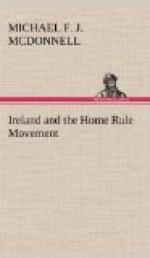The bearing of the transit question on the agricultural problem is seen by a consideration of the rates for every form of farm produce, which in Ireland are fifteen to twenty per cent. of their value. On the Continent the average is five to six per cent., and in the United States and Canada it is three per cent. The discouragement of such a tariff to agricultural enterprise has had a great bearing on the transformation of plough land into cattle ranches, and the extent to which this has occurred may be seen from the fact that there are to-day twelve million acres of pasture to three millions of arable land in the island, and fertile land, like that of the plains of Meath, is to be seen growing, not corn for men, but grass for cattle. The success of the country in stock-raising may very easily be rendered nugatory if the exclusion of Argentine and Canadian cattle from the English market be ended by the passing of an Act giving the Board of Agriculture a discretionary power to maintain or remove the embargo on their importation, according as the danger of an introduction of cattle disease exists or disappears. The enormous import trade which is done in Danish butter, Italian cheese, and even Siberian eggs, shows the commercial possibilities of farm produce when freights are low. As a tangible example of the discrimination which the railways pursue may be mentioned the fact that the freight for goods per ton from Liverpool to Cavan is 10s. 8d., while that from Cavan to Liverpool is 16s. 8d. The numbers employed on agriculture have diminished, not only in proportion to the population but also relatively to its decrease. According to Mr. Charles Booth land employs as many people to-day in England as it did in 1841, and it probably supports nearly as many, and though in that country, building and manufacture employ a vast number more, in Ireland there has been in the same time a decrease of nearly eleven per cent. of those so employed—the total decrease being 626,000.
The population of England has in the last century been multiplied by four, that of Scotland has increased threefold, while that of Ireland has decreased by one-fourth. If we take the last sixty years it will be seen that the people of England have doubled their numbers, but those of Ireland have divided by two. It would be idle to pretend that the great exodus which took place after the famine was in all respects to be regretted. The abnormal increase in population which took place in the first forty years of the nineteenth century was in itself out of all proportion to the increase of productive capacity in the country, and was closely related to the unnatural inflation of prices, and consequent spurious appearance of prosperity, due to the great war. When the climax came this was rapidly followed by a reaction, and when emigration reduced the numbers of eight million people who were in the island in 1841, the modified competition in the labour market and in the land market tended to restore prices to a normal figure.




